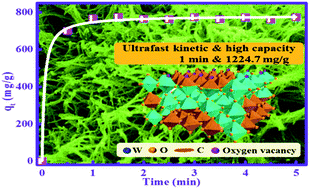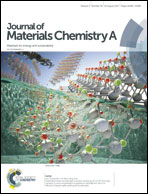Unexpected ultrafast and high adsorption capacity of oxygen vacancy-rich WOx/C nanowire networks for aqueous Pb2+ and methylene blue removal†
Abstract
The development of advanced adsorbents with high adsorption capacity and fast adsorption rates is one of the most important issues for water treatment. Herein, oxygen vacancy-rich WOx/C inorganic–organic hybrid nanowire networks were prepared by a one-pot and high yield solvothermal method. With their unique intercrossed hierarchical structure and abundant active sites, the WOx/C networks exhibited high adsorption capacities of ∼1224.7 and 1188.3 mg g−1 for the removal of Pb2+ and MB, respectively. Moreover, the adsorption equilibriums of Pb2+ and MB onto WOx/C networks can be achieved within only ∼1 min, which were among the fastest of those previously reported for Pb2+ and MB adsorbents. These unexpected ultrafast and high adsorption capacities are attributed not only to the unique network nanostructure, but also to the enriched oxygen vacancies onto which small carbonaceous molecules can attach with high affinities, which may serve as anchoring sites for Pb2+ ions or dyes. The removal mechanism of Pb2+ and MB on WOx/C can be attributed to ion exchange, π–π interaction, hydrogen bonding and/or electrostatic attraction. This study not only provides a new strategy to design inorganic–organic hybrid adsorbents, but also demonstrates its prospective application in adsorptive removal and/or recovery of heavy metals and organic pollutants on a large scale.



 Please wait while we load your content...
Please wait while we load your content...